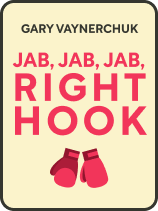

This article is an excerpt from the Shortform book guide to "Jab, Jab, Jab, Right Hook" by Gary Vaynerchuk. Shortform has the world's best summaries and analyses of books you should be reading.
Like this article? Sign up for a free trial here .
What is Jab, Jab, Jab, Right Hook by Gary Vaynerchuk about? How has social media changed the marketing landscape? How can you take advantage of social media to boost own business?
Jab, Jab, Jab, Right Hook by Gary Vaynerchuk is about the rise of social media marketing. Vaynerchuk compares marketing to boxing because both are aggressive and strategic, and both require dedication and hard work. Learn how “jabs” and “right hooks” can increase your company’s presence and increase sales.
Keep reading to learn more marketing tips from Jab, Jab, Jab, Right Hook by Gary Vaynerchuk.
Jab, Jab, Jab, Right Hook by Gary Vaynerchuk. What Is It About?
Boxing is a natural metaphor for marketing—boxing and marketing are both aggressive and strategic, and both require dedication and hard work. In Jab, Jab, Jab, Right Hook by Gary Vaynerchuk, he explains how to land perfect punches in the social media arena.
First, we’ll look at how the rise of social media has changed marketing. Next, we’ll look at how to create great social media content. Finally, we’ll look at individual platforms and how to take advantage of their specific features.
(Note: Jab, Jab, Jab, Right Hook by Gary Vaynerchuk was published in 2013, so some of the content may be outdated.)
The Rise of Social Media
These days, almost everyone has a mobile device and many people are on social media. There are 325 million mobile subscriptions in the US and the author suspects that almost half of the time people spend on their phones is used for social media.
In spite of social media’s popularity, many marketers and businesses are reluctant to embrace new platforms. This is for a variety of reasons, including feeling they don’t have time or thinking the new platform is silly. This means that any brands that do embrace new platforms have a head start. Often, early adopters are small businesses because they don’t have the same PR and legal red tape that larger companies do.
The small business advantage disappears as new platforms become more mainstream and large companies work through their red tape. However, even if larger companies have higher budgets and more staff that can interact with the community, small businesses can still compete by increasing their effort. If you work hard to create great content and show the community you care, you’ll do well even if other companies have more resources. Being cared for by a business is so rare that it surprises people and leaves an impression.
What’s Changed in the Era of Social Media
The rise of social media has ushered in many changes in marketing:
- Shorter campaign length. Today, every day requires new content.
- Increased customer interaction. Customers can now engage with brands rather than passively consuming their ads. They can like posts, ask questions, and demand attention before agreeing to buy something.
- Increased affordability of advertising. It’s free to set up a presence on social media and some platforms offer affordable advertising.
- Decreased reliance on traditional media companies. Now, customers can directly access their customers on their own, without the help of a TV or radio ad. Any brand can become its own media company.
What Hasn’t Changed in the Era of Social Media
Social media has changed a lot of things for marketers, but there are some constants:
- Good timing is critical. You still need to connect with customers at the time and place when they’re most likely to purchase.
- Storytelling is key. No matter where you’re telling your story, you need to write it in a way that creates enough emotion to make customers want to answer your calls to action.
- Long-form content continues to be relevant. Social media content is becoming shorter and shorter, but long-form content still has its place. Books, movies, and YouTube videos probably won’t disappear.
- Marketing requires lifelong learning. New platforms and technologies are coming into being every day. You’ll need to learn new skills on an ongoing basis.
- You need heart, sincerity, engagement, commitment, and hustle. Marketing is hard and it takes work.
- There are two types of content, “jabs” and “hooks.” We’ll cover these in more detail in the next section.
Jabs and Right Hooks
According to Jab, Jab, Jab, Right Hook by Gary Vaynerchuk, a metaphorical jab is content that builds the relationship between you and your customer. Jabs should be intriguing, engaging, and/or create some sort of emotional response, such as making people laugh.
Example: Oreo tweeted this when the power went out during the 2013 Super Bowl. Oreo wasn’t trying to sell anything with this tweet; they were just trying to entertain people and show the brand’s humanity.
A metaphorical right hook is marketing content that includes a call to action and aims to convert a sale. Right hooks need to be easily comprehensible, work on all digital devices, including mobile, and meet the conventions of the platforms they appear on.
While the right hook is the content that creates a sale, jabs are just as important. If you were in a boxing ring with an opponent, you couldn’t just throw a right hook out of nowhere; your opponent would slip out of the way. You need to set up an opportunity to throw the hook by throwing jabs first. It’s the same in marketing—before you ask a customer for a sale, you need to build a relationship with them. There’s no universal combination of jabs and hooks that result in a sale every time—you’ll have to experiment.
Eight Tips for Creating Great Content
Now that you better understand the social media arena, it’s time to learn about how to create great jabs and hooks. These eight tips apply to any platform:
1. Use native content including high-quality images. Native content is content that mirrors the form and content of the platform it appears on. People like native content because it provides the same value as user-generated content. All platforms use high-quality photographs.
- For example, people go on Pinterest to look at aspirational images. If your brand shares aspirational images, people on Pinterest will be interested in your posts.
2. Tailor your jabs to the customer’s desires. On social media, people want utility, an escape, and a connection with others. Invite people to engage by sparking conversations or using games or contests, and showcase your fans’ responses. Make your content interesting and intriguing.
- For example, if you’re a cosmetics company, you might create an Instagram contest that encourages people to share photos of themselves wearing your products.
3. Make sure your hooks include a price and link to the right place. People don’t want to be linked to the home page of a website when they’re trying to access the product page of whatever’s featured in the post.
- For example, on Tumblr, Target posted about a dress and included links that took customers directly to the dress product page.
4. Take advantage of pop culture. If you show your followers that you’re in their loop and share their interests, whether that’s by talking about a popular song or sharing celebrity gossip, your brand will come across as human.
- For example, on Tumblr, comedian Paul Scheer posted about Breaking Bad to insert himself into a topic that people were already discussing.
5. Make your content micro. Microcontent is short content that responds to current events and culture. Your text should always be short and simple.
- For example, on National Sibling Day, Netflix tweeted the line “Hey brother” from Arrested Development, which Netflix had just recently aired. The only other text was a hashtag and link.
6. Maintain your identity. Know who your brand is and know its message, and always keep both of these things in mind while creating your content. It’s fine to share different stories and use different tones on different platforms, but your content should always be in line with your brand’s identity.
- For example, include your logo or slogan on the images you post on Facebook.
7. Cross-pollinate. If you have a good following on one platform, use it to advertise your presence on a platform where your following is smaller.
- For example, Surf Taco has a Twitter following that’s almost 13 times larger than its Instagram following, and on Twitter, they linked to an Instagram photo.
8. Don’t interrupt. Don’t use banner ads or pop-ups, which are highly interruptive. When you interrupt someone from their media with an ad, at best they’re annoyed, at worst, they now hate your brand.
Specific Platforms
While there are some techniques that apply to any social media platform, each platform has its own features, and native content looks different on all of them. Jab, Jab, Jab, Right Hook by Gary Vaynerchuk covers how to create platform-specific content for five major social media platforms:
Facebook is a social media site that allows users to share text, photos, and videos with their network. As of December 2012, there were over a billion monthly active Facebook users. People use Facebook to find out what people they know are doing and socialize.
Notable Features
- Advanced analytics. Studying Facebook’s analytics can tell you a lot about the human psyche, and you can use this data to make your content more effective.
- Huge amount of content. Part of the reason Facebook is such a good marketing tool is that there are so many people on it, but all of these people create content yours has to compete with.
- Free targeting functionality. Facebook offers settings that allow you to make certain posts visible to only a certain demographic, which is ideal for right hook posts.
- Use of curating algorithms. Facebook doesn’t want users to see posts they’re not interested in (because if they get bored they’ll leave the site), so Facebook uses algorithms to curate people’s News Feeds. Only 3-5% of your content shows up on your fans’ News Feeds organically (“organically” means if no one shares the story or you don’t pay to make it more visible.)
- Paid advertising. Facebook has two types of ads, and the most effective is sponsored stories. A sponsored story is a post that will be visible to non-followers and more than 3-5% of your fans’ News Feeds.
Three Tips for Great Facebook Content
- Choose the correct format. On Facebook, you can create a link-based post, which shows a small photo beside the link, or a photo-based post, which prioritizes the photo. If you have a nice photo, choose the photo-based post.
- Optimize for mobile. More people than ever are accessing Facebook sites on mobile devices, so make sure text on your images is legible at small sizes and not cut off if cropped by the smaller mobile screen.
- Regulate the comments section. Many people try to piggyback on popular fan pages to sell their own products or business, which is content that people aren’t interested in, so you need to remove it. You also need to respond to people’s comments and questions.
Twitter is a microblogging platform and posts are called “tweets.” As of December 2012, there were 500 million Twitter users worldwide, and most users were young and urban. People mainly use Twitter to share information and news.
Notable Features
- Mobile-friendly. Twitter is one of the most mobile-friendly platforms.
- Very public. Most tweets are public to the entire internet, even to people who don’t have accounts.
- Huge potential for community engagement. Unlike other platforms where you can only talk to people who are already following you, on Twitter, you can initiate conversations with potential new customers.
- Retweeting features. On Twitter, you can retweet (reshare) other people’s tweets. This allows you to rework other people’s content instead of having to come up with your own.
- The importance of context over content. Like Facebook, there’s an overwhelming amount of content on Twitter and if you’re only tweeting about your products, you’re not going to stand out. You can stand out by putting your own spin on the news and augmenting the existing content with commentary, humor, or voice.
- Trend-tracking features. Trends are words, topics, and hashtags that are popular at any given moment. You can use settings to track trends (at levels ranging from regional to worldwide) and then use that knowledge to post timely content with appropriate context.
- Paid advertising. On Twitter, you can advertise via a promoted tweet. Promoted tweets are clearly labeled “Promoted” and are given more visibility than other tweets.
Four Tips for Great Twitter Content
- Use memorable and idiosyncratic hashtags. Hashtags should match the voice of your brand. Additionally, they should be native to Twitter (they should be employed the same way users employ them).
- Pay attention to voice. Your voice should sound like your brand and be appropriate to the Twitter audience (which tends to enjoy irony).
- Break the news first. If you can release news people are interested in before anyone else does, it’ll be your tweet that’s reshared as the news goes around.
- Trendjack. Trendjack refers to using hashtags that are trending to boost the visibility of your tweet. Twitter users regularly look through the list of posts that use the trending hashtags, and if you use a trend, your tweets are more likely to be seen by people outside your existing network.
Pinterest is a social bookmarking site that allows people to save posts they like (“pins”) into collections (“boards”). At the author’s time of writing, Pinterest had 48.7 million users, many of whom were women and mothers. People use Pinterest because it’s aspirational—people pin images of what they’d like their lives to look like, not actually what they are.
Notable Features
- Purchase-friendly. A Steelhouse study found that users are almost 80% more likely to buy something they see on Pinterest than on Facebook. Twitter produces only a quarter of the revenue-per-click of Pinterest.
- Distinction between boards and brand pages. People can follow your collections separately from your brand, so you have more freedom to explore your brand’s identity.
- Caption features. You can accompany all your images with custom captions or descriptions.
- Repinning features. Like Twitter, you can reuse and upcycle other people’s content. This might not help you make sales, but it’s good for building relationships and establishing trust.
- Rabbitholing opportunities. Most people on Pinterest don’t go directly to a brand’s page; they arrive there by clicking on images they’re interested in that eventually lead to the page. People have the potential to end up on your brand page no matter what board they initially started at.
Three Tips for Great Pinterest Content
- Post aspirational images. People go on Pinterest to imagine what their lives could be like, so post images of luxury, beauty, and fun. Ask yourself if the image in the pin is high-quality enough to be printed in a magazine. If it isn’t, don’t post it.
- Give your boards and photos good titles and descriptions and categorize images so people don’t have to debate where to repin. A good filing system will help people find and interact with your pins.
- Use infographics. Infographics are popular and create engagement.
Instagram is a photo and video-sharing social media platform that’s owned by Facebook. Instagram is used by younger demographics and as of December 2012, there were 130 million monthly active users. People like Instagram because they like interacting with others visually.
Notable Features
- No reposting. You can only post your own content, not reshare other people’s. However, you can get around this by using outside apps, or by screenshotting a post and then posting the screenshot.
- No linking. Posts can’t be linked to outside sites. However, you can get around this by putting a URL into the photo’s description.
- Integration with other social media platforms. Users can connect their Instagram accounts to Twitter and Facebook.
- “Baked-in utility.” Baked-in utility means a platform is good at what it’s designed to do. Instagram is designed to help users take good smartphone photos.
- Explore. Explore is an Instagram page that features the best content on the site. If you can get your content featured on Explore, its visibility increases exponentially—everyone, not just your followers, will see it.
Four Tips for Great Instagram Content
- Use hashtags freely. On Twitter, hashtags are used sparingly for humor and irony, but on Instagram, use as many as you want because they’re how people find your posts (clicking on a hashtag brings users to a page of all the images that use that hashtag).
- Cater to the younger generations. Many people on Instagram are young.
- Create holiday-themed content. Holiday-themed photos tend to create engagement because they evoke excitement and nostalgia.
- Pay attention to placement. For instance, if your image has a heart in it, crop the image so that the heart of the “like” button lines up with it.
Tumblr
Tumblr was originally a blogging platform, but in January 2012 it redesigned its dashboard to become more social. Tumblr is mainly used by 18-to-34-year-olds and had 132 million monthly users as of June 2013. Tumblr is more of a publishing platform than a consuming one, but people do consume media on it, and quickly.
Notable Features
- Customizable homepage. Unlike Twitter or Facebook, you can choose your art, logo placement, color, format, and font, which allows you to better express your brand’s identity.
- Interest-based connections. Connections are made based on interest, not who you already know. If you post content people are interested in and tag it appropriately, they’ll find it, whether or not they follow you.
- GIF support. GIFs are soundless videos that play on a loop without having to be clicked. They’re both animated and live-action and often captioned. (Shortform note: In 2013, when Jab, Jab, Jab, Right Hook was published, Tumblr was the only platform that supported GIFs. Today, most of the platforms listed in this summary support them too.)
- Relatively new. Fewer businesses are on Tumblr than other platforms, so you have a chance to corner the market before your competitors arrive.
Four Tips for Great Tumblr Content
- Customize your homepage to showcase your brand identity. You can use the same fonts and colors as your logo.
- Use GIFs. GIFs are engaging and can be used to make people laugh.
- Be cool. Tumblr’s audience is young, cool, and interested in exclusive content. Consider black and white images and pop culture references.
Use appropriate tags. Tags help people find your posts, so choose specific ones.

———End of Preview———
Like what you just read? Read the rest of the world's best book summary and analysis of Gary Vaynerchuk's "Jab, Jab, Jab, Right Hook" at Shortform .
Here's what you'll find in our full Jab, Jab, Jab, Right Hook summary :
- Why creating strong social media content is like boxing
- How the rise of social media has brought many changes to marketing
- How to build a connection and then convert a sale






